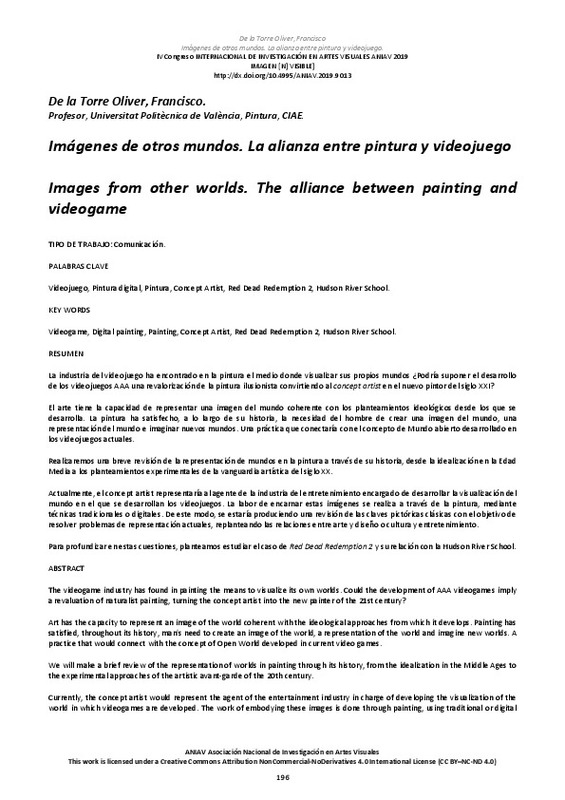JavaScript is disabled for your browser. Some features of this site may not work without it.
Buscar en RiuNet
Listar
Mi cuenta
Estadísticas
Ayuda RiuNet
Admin. UPV
Imágenes de otros mundos. La alianza entre pintura y videojuego
Mostrar el registro sencillo del ítem
Ficheros en el ítem
| dc.contributor.author | Torre Oliver, Francisco José de la
|
es_ES |
| dc.date.accessioned | 2019-10-24T09:32:35Z | |
| dc.date.available | 2019-10-24T09:32:35Z | |
| dc.date.issued | 2019-09-10 | |
| dc.identifier.isbn | 9788490487662 | |
| dc.identifier.uri | http://hdl.handle.net/10251/129398 | |
| dc.description.abstract | [ES] La industria del videojuego ha encontrado en la pintura el medio donde visualizar sus propios mundos ¿Podría suponer el desarrollo de los videojuegos AAA una revalorización de la pintura ilusionista convirtiendo al concept artist en el nuevo pintor del siglo XXI? El arte tiene la capacidad de representar una imagen del mundo coherente con los planteamientos ideológicos desde los que se desarrolla. La pintura ha satisfecho, a lo largo de su historia, la necesidad del hombre de crear una imagen del mundo, una representación del mundo e imaginar nuevos mundos. Una práctica que conectaría con el concepto de Mundo abierto desarrollado en los videojuegos actuales. Realizaremos una breve revisión de la representación de mundos en la pintura a través de su historia, desde la idealización en la Edad Media a los planteamientos experimentales de la vanguardia artística del siglo XX. Actualmente, el concept artist representaría al agente de la industria del entretenimiento encargado de desarrollar la visualización del mundo en el que se desarrollan los videojuegos. La labor de encarnar estas imágenes se realiza a través de la pintura, mediante técnicas tradicionales o digitales. De este modo, se estaría produciendo una revisión de las claves pictóricas clásicas con el objetivo de resolver problemas de representación actuales, replanteando las relaciones entre arte y diseño o cultura y entretenimiento. Para profundizar en estas cuestiones, planteamos estudiar el caso de Red Dead Redemption 2 y su relación con la Hudson River School. | es_ES |
| dc.description.abstract | [EN] The videogame industry has found in painting the means to visualize its own worlds. Could the development of AAA videogames imply a revaluation of naturalist painting, turning the concept artist into the new painter of the 21st century? Art has the capacity to represent an image of the world coherent with the ideological approaches from which it develops. Painting has satisfied, throughout its history, man's need to create an image of the world, a representation of the world and imagine new worlds. A practice that would connect with the concept of Open World developed in current video games. We will make a brief review of the representation of worlds in painting through its history, from the idealization in the Middle Ages to the experimental approaches of the artistic avant-garde of the 20th century. Currently, the concept artist would represent the agent of the entertainment industry in charge of developing the visualization of the world in which videogames are developed. The work of embodying these images is done through painting, using traditional or digital techniques. In this way, a review of the classic pictorial keys with the aim of solving current representation problems, rethinking the relationship between art and design or culture and entertainment, would be taking place. To delve into these issues, we propose to study the case of Red Dead Redemption 2 and its relationship with the Hudson River School | es_ES |
| dc.format.extent | 9 | es_ES |
| dc.language | Español | es_ES |
| dc.publisher | Editorial Universitat Politècnica de València | es_ES |
| dc.relation.ispartof | IV Congreso Internacional de investigación en artes visuales: ANIAV 2019 Imagen [N] visible | es_ES |
| dc.rights | Reconocimiento - No comercial - Sin obra derivada (by-nc-nd) | es_ES |
| dc.subject | Arte | es_ES |
| dc.subject | Producción artística | es_ES |
| dc.subject | Estética | es_ES |
| dc.subject | Teoría del arte | es_ES |
| dc.subject | Gestión cultural | es_ES |
| dc.subject | Educación artística | es_ES |
| dc.subject | Investigación artística | es_ES |
| dc.subject | Videojuego | es_ES |
| dc.subject | Pintura digital | es_ES |
| dc.subject | Pintura | es_ES |
| dc.subject | Concept artist | es_ES |
| dc.subject | Red Dead Redemption 2 | es_ES |
| dc.subject | Hudson River School | es_ES |
| dc.title | Imágenes de otros mundos. La alianza entre pintura y videojuego | es_ES |
| dc.title.alternative | Images from other worlds. The alliance between painting and videogame | es_ES |
| dc.type | Capítulo de libro | es_ES |
| dc.type | Comunicación en congreso | es_ES |
| dc.identifier.doi | 10.4995/ANIAV.2019.2019.9013 | |
| dc.rights.accessRights | Abierto | es_ES |
| dc.contributor.affiliation | Universitat Politècnica de València. Departamento de Pintura - Departament de Pintura | es_ES |
| dc.contributor.affiliation | Universitat Politècnica de València. Centro de Investigación Arte y Entorno - Centre d'Investigació Art i Entorn | es_ES |
| dc.contributor.affiliation | Universitat Politècnica de València. Facultad de Bellas Artes - Facultat de Belles Arts | es_ES |
| dc.description.bibliographicCitation | Torre Oliver, FJDL. (2019). Imágenes de otros mundos. La alianza entre pintura y videojuego. En IV Congreso Internacional de investigación en artes visuales: ANIAV 2019 Imagen [N] visible. Editorial Universitat Politècnica de València. 196-204. https://doi.org/10.4995/ANIAV.2019.2019.9013 | es_ES |
| dc.description.accrualMethod | OCS | es_ES |
| dc.relation.conferencename | IV Congreso Internacional de Investigación en Artes Visuales. ANIAV 2019. Imagen [N] Visible | es_ES |
| dc.relation.conferencedate | Julio 03-05, 2019 | es_ES |
| dc.relation.conferenceplace | Valencia, Spain | es_ES |
| dc.relation.publisherversion | http://ocs.editorial.upv.es/index.php/ANIAV/ANIAV2019/paper/view/9013 | es_ES |
| dc.description.upvformatpinicio | 196 | es_ES |
| dc.description.upvformatpfin | 204 | es_ES |
| dc.type.version | info:eu-repo/semantics/publishedVersion | es_ES |
| dc.relation.pasarela | OCS\9013 | es_ES |








